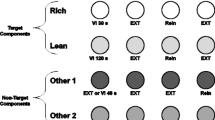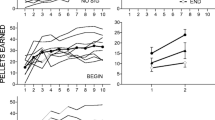Abstract
Pigeons learned to discriminate between a stimulus which signalled a variable-interval (VI) schedule of reinforcement and a stimulus which signalled extinction. In Experiment 1, for one group of four pigeons, a line- tilt stimulus was associated with extinction, and for another group of four pigeons this stimulus was uncorrelated with the availability of reinforcement. During a resistance to reinforcement phase, responses to this line-tilt stimulus and to a novel stimulus were reinforced on a VI schedule. Statistical comparisons of the response rates to these test stimuli indicated that subjects consistently responded at a higher rate to the line-tilt stimulus than to the novel stimulus. Between-groups comparisons of response rates to the line-tilt stimulus indicated no reliable differences. These results indicated that a novel stimulus had strong response suppression or inhibition effects when compared to stimuli to which the subjects had had previous exposure. However, stimuli which were correlated or uncorrelated with the availability of reinforcement were equivalent in their inhibitory or response suppression effects.
Experiment 2 used a within-subject design to replicate and extend the findings of Experiment 1. The data from Experiment 2 also indicated that a novel stimulus was a very strong suppressor of responding. However, these data also indicated that a stimulus that had signalled extinction was a stronger inhibitor of responding than a stimulus that had been uncorrelated with reinforcement. These findings are discussed in terms of the stimulus- reinforcer and response-reinforcer contingency arrangements which produce inhibitory stimulus control. Methodological considerations for the detection of inhibition are also discussed.
Similar content being viewed by others
References
GUTMAN, A. 1977. Positive contrast, negative induction, and inhibitory stimulus control in therat. Journal ofthe Experimental Analysis ofBehavior, 27, 219–233.
HEARST, E. 1972. Some persistent problems in the analysis of conditioned inhibition. In R.A. Boakes & M.S. Halliday (Eds.), Inhibition and Learning. London: Academic Press.
HEARST, E., BESLEY, S., & FARTHING, G.W. 1970. Inhibition and stimulus control of operant behavior. Journal of the Experimental Analysis of Behavior, 14, 373–409.
KARPICKE, J., & HEARST E. 1975. Inhibitory control and errorless learning. Journal of the Experimental Analysis of Behavior, 23, 159–166.
KREMER, E.F. 1971. Truly random and traditional control procedures in Cer conditioning in the rat. Journal of Comparative and Psysiological Psychology, 76, 441–448.
LUBOW, R.E. 1973. Latent inhibition. Psychological Bulletin, 79, 398–407.
LYONS, J. 1969. Stimulus generalization as a function of discrimination learning with and without errors, Science, 163, 490–491.
MACKINTOSH, N.J. 1973. Stimulus selection: Learning to ignore stimuli that predict no change in reinforcement. In R.A. Hinde & J. Stevenson-Hinde (Eds.), Constraints on learning: Limitations and predispositions. London: Academic Press.
NEWMAN, F.L., & BENEFIELD, R.L. 1968. Stimulus control, cue utilization, and attention: Effects of discrimination training. Journal of Comparative and Physiological Psychology, 66, 101–104.
PAVLOV, I.P. 1927. Conditioned reflexes ftrans. by G.V. Anrep). London: Oxford University Press.
RAND, J. F. 1977. Behavior observed during S-in a simple discrimination learning task. Journal of the Experimental Analysis of Behavior, 27, 103–117.
RILLING, M., CAPLAN, H..J., HOWARD, R.C., & BROWN, C.H. 1975. Inhibitory stimulus control following errorless discrimination learning. Journal of the Experimental Analysis of Behavior, 24, 21–133.
TERRACE, H..S. 1966. Discrimination learning and inhibition. Science, 154, 1677–1680.
TERRACE, H..S. 1968. Discrimination learning, the peak shift, and behavioral contrast. Journal of the Experimental Analysis of Behavior, 11, 727–741.
TERRACE, H.S. 1972. By-products of discrimination learning. In G.H. Bower (Ed) The psychology oflearning and motivation. New York: The Academic Press.
WASSERMAN, E.A. & MOLINA, E.J. 1975. Explicitly unpaired key light and food presentations: Interference with subsequent auto-shaped key pecking in pigeons. Journal of Experimental Psychology: A nimal Behavior Processes, 104, 30–38.
ZENTALL, T., COLLINGS, N., & HEARST E. 1971. Generalization gradients around a formerly positive S. Psychonomie Science, 22, 257–259.
Author information
Authors and Affiliations
Rights and permissions
About this article
Cite this article
Williamson, D.A., Leeming, F.C., Sewell, W.R. et al. The Detection of Inhibition Using the Resistance to Reinforcement Method. Psychol Rec 29, 231–244 (1979). https://doi.org/10.1007/BF03394609
Published:
Issue Date:
DOI: https://doi.org/10.1007/BF03394609




